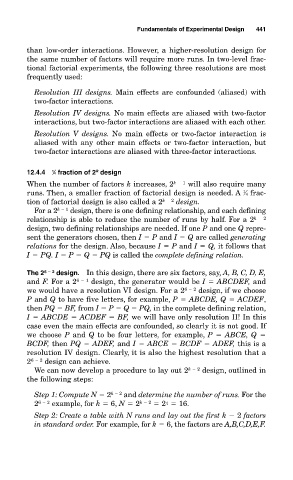Page 482 - Design for Six Sigma a Roadmap for Product Development
P. 482
Fundamentals of Experimental Design 441
than low-order interactions. However, a higher-resolution design for
the same number of factors will require more runs. In two-level frac-
tional factorial experiments, the following three resolutions are most
frequently used:
Resolution III designs. Main effects are confounded (aliased) with
two-factor interactions.
Resolution IV designs. No main effects are aliased with two-factor
interactions, but two-factor interactions are aliased with each other.
Resolution V designs. No main effects or two-factor interaction is
aliased with any other main effects or two-factor interaction, but
two-factor interactions are aliased with three-factor interactions.
k
12.4.4 1 ⁄4 fraction of 2 design
When the number of factors k increases, 2 k 1 will also require many
runs. Then, a smaller fraction of factorial design is needed. A ⁄4 frac-
1
tion of factorial design is also called a 2 k 2 design.
For a 2 k 1 design, there is one defining relationship, and each defining
relationship is able to reduce the number of runs by half. For a 2 k 2
design, two defining relationships are needed. If one P and one Q repre-
sent the generators chosen, then I P and I Q are called generating
relations for the design. Also, because I P and I Q, it follows that
I PQ. I P Q PQ is called the complete defining relation.
The 2 6 2 design. In this design, there are six factors, say, A, B, C, D, E,
and F. For a 2 6 1 design, the generator would be I ABCDEF, and
we would have a resolution VI design. For a 2 6 2 design, if we choose
P and Q to have five letters, for example, P ABCDE, Q ACDEF,
then PQ BF, from I P Q PQ, in the complete defining relation,
I ABCDE ACDEF BF, we will have only resolution II! In this
case even the main effects are confounded, so clearly it is not good. If
we choose P and Q to be four letters, for example, P ABCE, Q
BCDF, then PQ ADEF, and I ABCE BCDF ADEF, this is a
resolution IV design. Clearly, it is also the highest resolution that a
2 6 2 design can achieve.
We can now develop a procedure to lay out 2 k 2 design, outlined in
the following steps:
Step 1: Compute N 2 k 2 and determine the number of runs. For the
2 6 2 example, for k 6, N 2 k 2 2 4 16.
Step 2: Create a table with N runs and lay out the first k 2 factors
in standard order. For example, for k 6, the factors are A,B,C,D,E,F.

